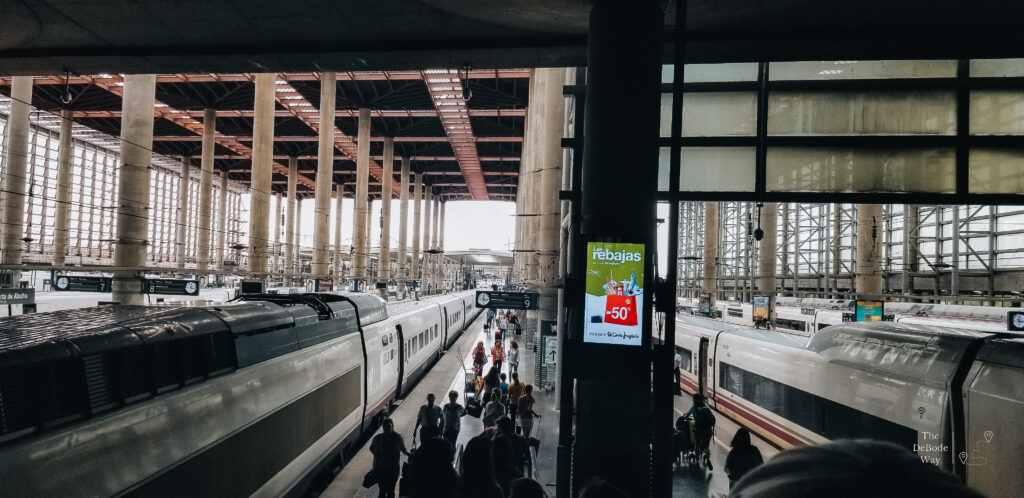This post contains affiliate links. We may earn commission on links you click or products you choose to purchase. Thank you.
Welcome back to our series on trip planning, where we spill the details on how we plan our adventures. So far, we’ve talked about buying your flights (Week 1), researching your destination and finding accommodations for your trip (Week 2), and finding things to do (Week 3). This week we’re talking about the last step in our process before being ready to head out on your exciting adventure: finding transportation for your trip. Read on!

Getting To the Airport
You may think we’ve already covered this, as we’ve already found our plane tickets, right? That’s all well and good but what happens once you get there?
Let’s take this one step at a time, shall we? First, how are you getting to the airport? For most folks, the immediate response is to park their car at the airport. Yes, it’s super convenient, but we don’t like to leave our car at the airport for two reasons.
- They’re expensive. Nobody wants to pay hundreds of dollars to just park their car. We’ve got way better things to do with that cash and so do you.
- Protection, or not. We live in the Midwest, and that means intense storms out of nowhere. I don’t want to come home and find my car buried in snow or the windows bashed in from a hailstorm. Plus, you know…tornadoes. Not fun.
Instead, we recommend grabbing an Uber (not happening where we are), or asking a neighbor, friend, or family member if they’d be willing to take you to the airport. If you have someone unfamiliar take you (like Uber or a taxi), just be mindful of the fact that you’re essentially telling a stranger you’re leaving your home unoccupied for a period of time. Most of the time, all will be well, but just to be safe, it’s a good idea to ask someone to keep an eye on things, just in case…
Storing Your Luggage
Hopefully, you made it to the airport and are on your flight, and if you’re like us, arrived with no sleep. Now you’re stumbling around your destination airport wondering what to do next.
If your hotel is nearby and you can check in early or they’re willing to hold your bags, grab a ride-share (check what is popular in your destination before you go and download their app), taxi, hotel shuttle (if they have one), or hop on the local metro system if it links to the airport (this is usually the least expensive option), and drop off your stuff. Most hotels we’ve stayed at are happy to hold your bags even if you can’t check in yet. This means you can set out to explore right away without having you tote your bags. If you aren’t sure, just ask the front desk.
If your hotel won’t hold your stuff, check a nearby train station for luggage lockers to stash your stuff and come back for it later. Or, check out a luggage storage service like Stasher to find locations all over the world to store your luggage for various lengths of time.
If you’re renting a car straight from the airport, easy peasy, stash your luggage inside, and get on with your journey. Friendly reminder: if you leave your luggage, even at your hotel, make sure you take your valuables (like your passport & money) with you just to be safe.
Once you’ve unloaded your luggage, you’re free to explore those to-dos you gathered last week and keep yourself awake until it’s time to sleep in the local time zone – this is important to reset your internal clock for your trip. It makes for a very long couple of days, but it makes the rest of your trip much smoother.
Getting Around In-Country
The local metro, tram, and train system are typically the easiest and least expensive ways to get around a city. If you prefer private taxis or cars, you do you. We usually rely on the rail systems when we’re in Europe as much as possible because it is extensive and very reliable! Typically, there are stops near all the best tourist destinations or within a few blocks of anywhere else you may want to go. In some cities, the rail system is also operated by the same system that operates the buses. This is helpful because you can buy one pass and use it on all modes of public transport in the city. Make sure to figure all this out before you go so you know what kind of pass you need and where to get it.

Speaking of passes, if you are planning to use a train frequently, look into a Eurail pass. These passes are a great way to save money if you’re planning on lots of train travel within or even between countries in continental Europe. You can choose your number of travel days anywhere from a few days to a month and pay one price for as many trains as you need within the time allotted. Don’t forget to check the train times and pick your seats to be sure there’s space for you.
If you’re staying in the city for a while, it might be worth getting a one-day pass with a Hop-On/Hop-Off bus company. The busses themselves almost always offer audio tours, but they’re a great way to get your bearings around the city, and most of these companies stop at the major tourism destinations. We’ve done this a few times on our first day in a new city to get our bearings, and then get a metro pass or something along these lines for the rest of the time we’re there as they’re significantly less expensive. You can always opt to only use the metro, but it can be difficult to see where you’re going and what’s around you if you’re underground. Give the map a good study before you set out so you aren’t stumbling around when you’re top-side again.
If you’re zipping between cities or countries, we highly recommend high-speed trains. They’ll have you there in no time and will have connections to the next rail system when you get there. Easy peasy. If there’s not a high-speed train and only a regular train, we still recommend that. You’ll get to see a lot more of the country and if it’s a long journey, we turn it into a workday or a great nap. If it’s a really long journey or even overnight, this is a great way to eliminate the expense of a hotel room for the night and wake up in a new destination. We’re trying out the Caledonian Sleeper train on our next trip to get us from Glasgow to London overnight. This way we don’t lose precious site-seeing time, but we will miss seeing the English countryside during the day since we’ll hopefully be getting some shut-eye in our cozy bunks. Trade offs.

If, like us, you try to spend the majority of your time outside of the cities, many train stations also have car rental companies either inside them or nearby. Some will deliver cars to a station, and for others, you may have to walk a few blocks to pick up your car. Many times this means you will be leaving from the center of a city, which is a little intimidating if it’s your first time driving in a new country. So, make sure you’re brushed up on all the rules of the road, and check if you need an international driver’s license before you go (get one here if you need it). Make all your car reservations online before you leave so you aren’t stranded when they’re all sold out. Also, double-check our post on credit card insurance policies for your rental cars, just to make sure you don’t spend unnecessary money.
Get Goin’!
In-country transportation is typically the last step in our planning process because by now, we’ve done all our research and we know where we want to go. We just need to make those final links to make the journey smooth and enjoyable. Make sure you sit down with your itinerary and understand how you will get from place to place and where stations, train lines, rental companies, etc. are located on the map. Once you make all those links – it’s time to book!




